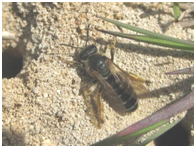 Genus: Adrena (an-DREE-nuh)
Genus: Adrena (an-DREE-nuh)
Common Name: Mining Bee
Size: 7-18 mm
If you find a patch of bare or lightly-vegetated ground filled with holes that look like they were poked in with a pencil, you may have found an aggregation of mining bees. Mining bees are medium-size bees that are generally dark in color. Individual species can range from black to dull metallic blue or green with bands of pale hair on the abdomen. These bands of hair give the bee a striped appearance, making it easy to confuse with the non-native honeybee.
These bees will nest in large groups, called aggregations, but each female digs her own nest tunnel. The Andrenas prefer sandy soil near or underneath plants. Each egg gets its own little side chamber off the main tunnel, coated in a secretion that soaks into the surrounding soil. The female polishes the brood chamber by rubbing it with her abdomen. Pollen is collected onto hairs, called scopa, on the upper portion of the hind legs, giving the female the appearance of carrying the pollen in her “armpits.” The female forms the pollen into a ball large enough to sustain the new bee into adulthood. She lays an egg on the pollen ball, then seals up the chamber. This is how the female mining bee spends her adult life – creating and provisioning the next generation.
The first time I came across an aggregation of mining bees I was standing in the center of it for about five minutes before I realized where I was. (I’d pulled over on the side of logging road to admire the valley below.) Once I noticed the bees flying in and out of holes in the ground, I stooped low for a closer look. The bees were very docile; timid, in fact. Which makes sense – although they nest near one another, it’s every bee for herself. Attacking a predator would only risk the bee’s life, so she stays hunkered down in her hole until I move away. Despite my presence for over 1/2-hour, none of the bees acted aggressively or attempted to sting me. (My point here is – if you find an Andrena aggregation – leave them be! They are not a threat.)
To find nesting Andrenas, walk along dirt or gravel roads with loose soil. Mining bees hatch in the spring, when temperatures get in the high-60’s (F). I’ve found them in May and June here in Pacific County, Washington.
{ 1 comment }
Play ground at the school had them when I was in grade school ( naselle) used to spend a bettor part of recess watching them didn’t know what the were at the time , just fascinated by them. J Bates